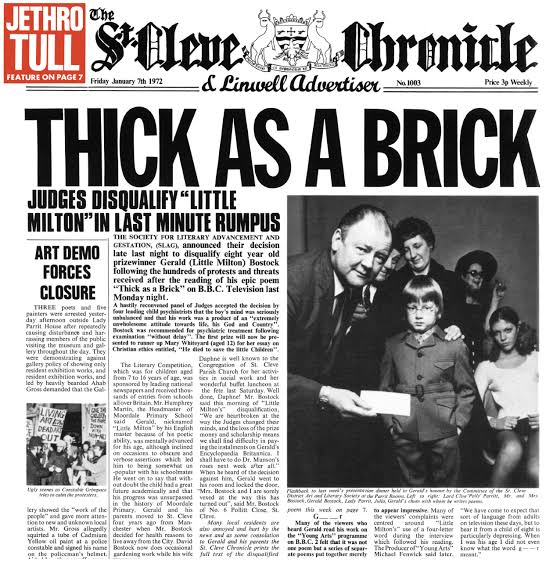 Released in 1972, Thick as a Brick is the fifth studio album by the iconic British progressive rock band Jethro Tull. Conceived as a single, continuous piece of music, the album spans over 40 minutes and is divided across both sides of the original vinyl. It remains a hallmark of the genre, celebrated for its ambitious structure, complex instrumentation, and satirical tone.
Released in 1972, Thick as a Brick is the fifth studio album by the iconic British progressive rock band Jethro Tull. Conceived as a single, continuous piece of music, the album spans over 40 minutes and is divided across both sides of the original vinyl. It remains a hallmark of the genre, celebrated for its ambitious structure, complex instrumentation, and satirical tone.
Origins and Concept
Jethro Tull, led by frontman Ian Anderson, created Thick as a Brick as a reaction to critics who labeled their previous album, Aqualung, a concept album. Anderson dismissed the notion but decided to lean into the idea with Thick as a Brick, crafting an elaborate mock-concept album.
The album’s fictional premise centers around an eight-year-old boy, Gerald Bostock, whose poem “Thick as a Brick” was purportedly rejected from a literary competition due to its controversial nature. The album’s liner notes further this satire, presenting an entire fictional newspaper, The St. Cleve Chronicle & Linwell Advertiser, filled with absurd articles and ads that expand on Bostock’s tale.
Musical Structure and Themes
Musically, Thick as a Brick is a progressive rock masterpiece, weaving together recurring motifs, intricate time signatures, and a blend of acoustic and electric instrumentation. The piece transitions seamlessly between soft, folk-inspired melodies and explosive rock segments, showcasing the band’s technical prowess.
Lyrically, the album explores themes of societal conformity, individualism, and the absurdities of modern life. Anderson’s biting wit and poetic storytelling shine throughout, making the album a rich tapestry of satire and social commentary.
Reception and Legacy
Upon its release, Thick as a Brick received widespread acclaim for its innovation and complexity. It topped the Billboard 200 in the United States and solidified Jethro Tull’s status as one of the leading bands in progressive rock. Critics praised the album’s cohesiveness and ambition, though some found its satirical tone divisive.
Decades later, the album continues to influence musicians and resonate with fans. It is often cited as one of the greatest progressive rock albums of all time and has been reissued in various formats, including deluxe editions featuring remastered audio and bonus content.
Cultural Impact
Thick as a Brick is more than an album; it is an experience that encapsulates the spirit of progressive rock’s golden age. Its elaborate packaging, including the mock newspaper, set a new standard for album art as a medium for storytelling. The record’s enduring popularity underscores its place as a cultural and musical landmark.
Jethro Tull revisited the album’s themes and concept with the 2012 sequel, Thick as a Brick 2: Whatever Happened to Gerald Bostock?, further exploring the fictional character’s life and legacy.
In summary, Thick as a Brick remains a shining example of Jethro Tull’s creativity and a testament to the power of music as a vehicle for narrative and satire. Its layered compositions and intricate storytelling continue to captivate audiences, ensuring its place in the pantheon of progressive rock legends.

Leave a Reply
You must be logged in to post a comment.